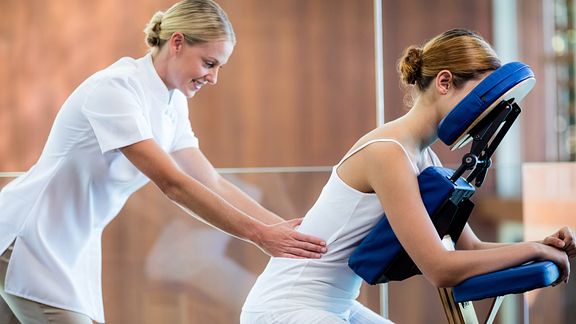Massage therapy can provide substantial healing and pain relief for many lower back problems. Specifically, for pain caused by a back strain, when the correct muscle is targeted, the pain can be controlled at its source—for quicker and lasting relief.
A skilled massage therapist can provide substantial back pain healing. Read Massage Therapy for Lower Back Pain
Two major muscles–the quadratus lumborum1 and the gluteus medius 2– play an important role in stabilizing and supporting your lower back and hips. When there is a change in the biomechanics of these muscles due to strain or fatigue, several problems, such as lower back pain, stiffness, and/or decreased mobility can occur.
See Back Muscles and Low Back Pain
Quadratus lumborum muscle massage
The quadratus lumborum muscle extends throughout your lower back and consists of several layers. This muscle is an extensor of the spine, allowing you to bend backward. The muscle also helps you bend your torso sideways.1
The quadratus lumborum muscle can become fatigued, stiff, strained, and/or painful when you perform certain daily activities, such as:
- Lifting that requires leaning over something, for example, getting groceries out of the trunk of your car
- Leaning over a sink while doing dishes
- Sitting slumped in a chair
- Running on uneven pavement
A sharp, stabbing, urgent pain in your low back may indicate a hypertonic (tight) quadratus lumborum. Sometimes, you may feel a dull, constant ache with some degree of stiffness.
The quadratus lumborum muscle may also develop painful trigger point nodules, cause entrapment of nerves within its fibers, or be subject to direct trauma, causing lower back pain.1
The muscle must be stretched and massaged simultaneously by your therapist in order to reduce lower back pain.
See Non-Surgical Treatments for Lower Back Pain
Gluteus medius muscle massage
The gluteus medius is a posterior hip (or buttocks) muscle. This muscle is a hip abductor,3,4 allowing you to lift your thigh and leg sideways, such as while getting out of a car. It is also responsible for keeping your hips leveled while standing on one leg (which is an integral part of your gait cycle as you’re walking). The biomechanics of the hip and spine are interconnected; a problem in your hip muscles can cause pain in your lower back.2
The gluteus medius muscle can become painful due to imbalance and/or weakness2 from several causes, such as5:
- Repetitive trauma to the muscle form running on soft surfaces
- Overuse of exercise equipment that requires hip abduction
- Sudden, strenuous physical activity
- Previous injury to the muscle
- Blunt trauma from hitting
Gluteus medius muscle pain mainly affects your lower back and buttocks. The pain may also be referred into the back of your thigh. Stiffness and fatigue are also commonly present, limiting the movement of your lower back and/or walking capacity.5
Ask your therapist to focus on the quadratus lumborum and gluteus medius muscles when you decide to have massage therapy for lower back pain. The muscles of the lower back and hip are interconnected for proper functioning. Unless a specific muscle is injured from direct trauma, it is more likely that the entire set of muscles are affected by fatigue, stress, and altered function.1
Most likely, your massage therapist is well-versed in the muscles that cause back pain. But, don’t hesitate to speak up and specifically request this type of massage if you suspect your pain is due to muscle dysfunction.
Learn more:
Referrence
- 1.Bordoni B, Varacallo M. Anatomy, Abdomen and Pelvis, Quadratus Lumborum. [Updated 2018 Dec 19]. In: StatPearls [Internet]. Treasure Island (FL): StatPearls Publishing; 2019 Jan-. Available from: https://www.ncbi.nlm.nih.gov/books/NBK535407/
- 2.Bishop BN, Greenstein J, Etnoyer-Slaski JL, Sterling H, Topp R. Electromyographic Analysis of Gluteus Maximus, Gluteus Medius, and Tensor Fascia Latae During Therapeutic Exercises With and Without Elastic Resistance. Int J Sports Phys Ther. 2018;13(4):668–675.
- 3.Whiler L, Fong M, Kim S, et al. Gluteus Medius and Minimus Muscle Structure, Strength, and Function in Healthy Adults: Brief Report. Physiother Can. 2017;69(3):212–216. doi:10.3138/ptc.2016-16
- 4.Cooper NA, Scavo KM, Strickland KJ, et al. Prevalence of gluteus medius weakness in people with chronic low back pain compared to healthy controls. European Spine Journal. 2015;25(4):1258-1265. doi:10.1007/s00586-015-4027-6
- 5.Waldman SD. Gluteus Medius Syndrome. In: Atlas of Uncommon Pain Syndromes. Elsevier; 2014:248-250. doi:10.1016/b978-1-4557-0999-1.00085-x

